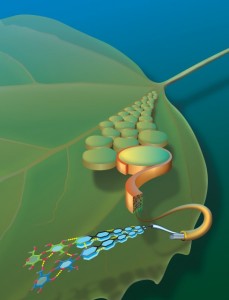May
4
Destroying the Tie That Binds
May 4, 2009 | 3 Comments
Los Alamos National Laboratory researchers have discovered a potential chink in the armor of fibers that make the cell walls of certain inedible plant materials so tough. The insight ultimately could lead to a cost-effective and energy-efficient strategy for turning biomass into alternative fuels.
The tie that bedevils using the great mass of available lignocellulosic biomass is biosynthesized in plant cells when molecules of glucose – the desired simple sugar – join into long chains through a process called polymerization. The plant then assembles these chains of cellulose into sheets. The sheets are held together by hydrogen bonds—an electrostatic attraction of a positive portion of a molecule to a negative portion of the same or neighboring molecule. Finally, the sheets are stacked atop one another, sticking to themselves by other types of attractions that are weaker than hydrogen bonds. The plant then spins these sheets into high-tensile-strength fibers of material.
The fibers are incredibly strong, but they are also incredibly resistant to the action of enzymes called cellulases that can crack the fibers back into their simple-sugar components. The ability to economically and easily break cellulose into sugars is desirable because the sugars can be used to create biofuel. Due to the tenacity of cellulose fibers, the industry currently lacks an energy-efficient and cost-effective method for turning inedible biomass such as miscanthus, switch grass or corn husks into a high volume source of biofuels.
Los Alamos researcher Paul Langan working with researchers from the U.S. Department of Agriculture and the Centre de Recherches sur les Macromolécules Végétales in France, used neutrons to probe the crystalline structure of highly crystalline cellulose, much like an X-ray is used to probe the hidden structures of the body. Langan and his colleagues found that cellulose generally has a well-ordered network of hydrogen bonds holding it together. But, the material also displays significant amounts of disorder, creating a different type of hydrogen bond network at certain surfaces. It’s those differences make the molecule potentially vulnerable to an attack by the cellulase enzymes.
In a paper published recently in an issue of Biomacromolecules, the Los Alamos researchers identified potential weaknesses among sheets of cellulose molecules comprising lignocellulosic biomass.
In the second part of the research Los Alamos researchers Tongye Shen and Gnana Gnanakaran reveal a new lattice-based model of crystalline cellulose. Their model predicts how hydrogen bonds in cellulose can shift to remain stable under a wide range of temperatures. This plasticity allows the material to swap different types of hydrogen bonds but also constrains the molecules so that they must form bonds in the weaker configuration described by Langan and his colleagues. Most important, Shen and Gnanakaran’s model identifies hydrogen bonds that can be manipulated via temperature differences to potentially make the material more susceptible to attack by enzymes that can crack the fibers into sugars for biofuel production. This work is published in this month’s Biophysical Journal.
Gnanakaran, who leads the theoretical portion of a large, multidisciplinary biofuels project at Los Alamos said, “We have been able to identify a chink in the armor of a very tough and worthy adversary—the cellulose fiber.”
Langan, director of the biofuels project points out, “These results are some of the first to come from this team, and eventually could point us toward an economical and viable process for making biofuels from cellulosic biomass.”
The news isn’t about a process that solves the binding, rather exposes the chemistry underlying the problem. That seemingly small bit of highly technical information could be the clue that triggers a great influx of new process research, as the targets are now better understood.
Encouraging for sure. But those hydrogen bonds are well known, high strength ties that bind together a massive share of the things on earth from the wood mankind loves use to the surprise that hydrogen bonds are the major binder in something as common and tough as concrete. Cracking through them in the biosphere would be a huge breakthrough.
It will be quite fascinating to see what research comes up with to break apart biological hydrogen bonds. Knowing what the ties are helps, but knowing they are hydrogen bonds is a sure concentrator of attention. Brute forces like heat might live on as the leader for a long time, giving the gasification folks a bit of confidence.
Comments
3 Comments so far



I liked newenergyandfuel.com a lot. It has lots of useful info. This article is very professionally written. newenergyandfuel.com I will be back for sure.
Great write up – Thank you for sharing
My cousin recommended this blog and she was totally right keep up the fantastic work!